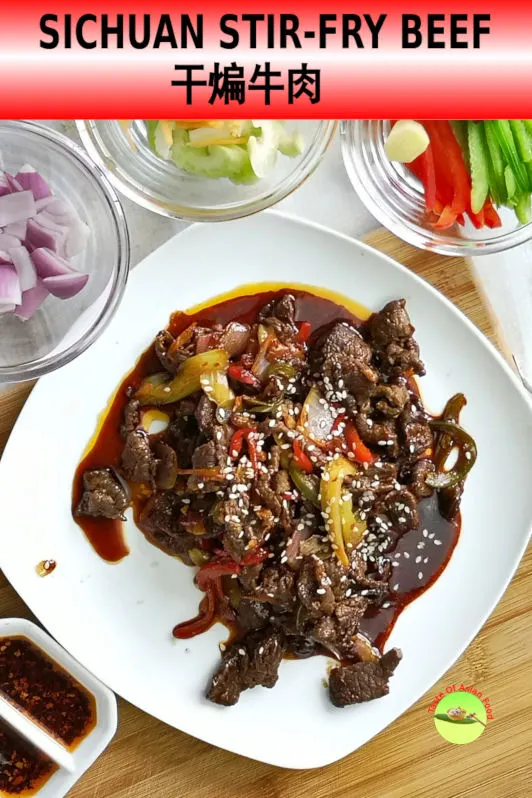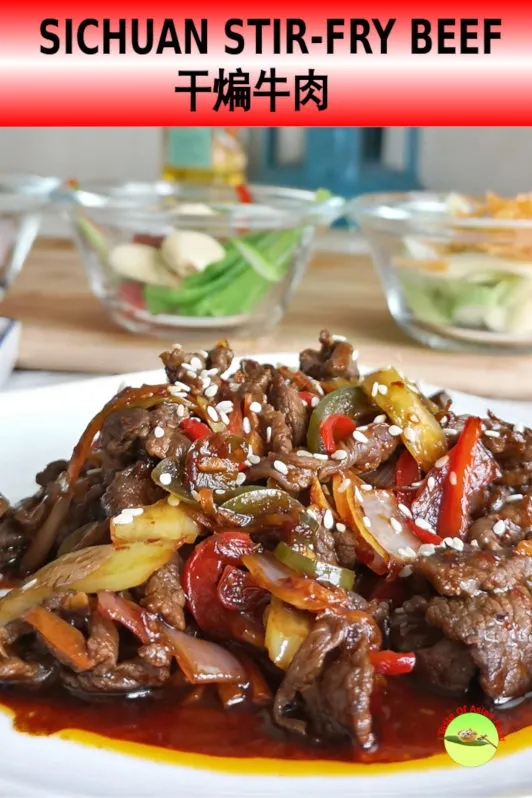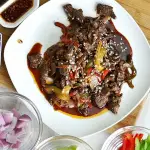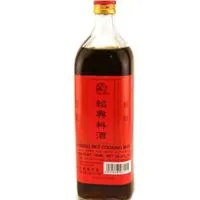As a Cantonese, Szechuan stir-fry beef 干煸牛肉 is one of my favorite dishes.
I grew up eating pure Cantonese food that is light and subtle. When I tried the Szechuan food that is bold and spicy, it captures my attention and wins over my palate right away. It tastes completely different from what we ever cook in my family. Since we do not cook Szechuan food in my family, it has become a novelty dish for me and takes every opportunity to dine in Szechuan restaurants whenever I eat out.
This Szechuan style stir-fry beef is based on the original ‘dry-fried beef / 干煸牛肉’ with a little more sauce. Cantonese likes sauces, and I tend to incorporate my deep-rooted cooking method subconsciously without realizing it. Therefore, it may not be authentic Szechuan, but the extra sauce is Heavenly tasty after mixing with steamed rice.
Note: This post may contain affiliate links. Please read my privacy policy for more info. I may receive commissions for purchases made through links in this post. As an Amazon Associate, I earn from qualifying purchases.

Here is my step by step detail breakdown of how to prepare the Szechuan stir-fry beef.
How to cook Szechuan beef stir-fry
1. Marinate the beef
The best cut of beef
Choose to use the best cut of beef, such as tenderloin. Alternatively, chucks or topside are acceptable.,
You can use the traditional way adopted by most Chinese chefs in the restaurant to tenderize the less expensive cut of beef. Just had one teaspoon of baking soda into half a liter of water. Place the block of meat into the mixture of baking soda and water for about 15 minutes, then cut the beef across the grain as usual.
Is it necessary to marinate?
Some people prefer to cut for beef slightly thicker and shear on the pan, like dealing with a steek. The goal is to treat it like a mini steak and to highlight the original flavor of the beef.
The other way is to cut it thin and marinate the beef with some salt and oil. I have tried both methods and conclude that marinated beef yields a better result.
Here are the steps
- Cut the beef into 4 to 5 cm wide strips.
- Cut the beef into thin slices across the grain
- Add a small amount of oil and salt to marinate the beef for at least 15 minutes.
2. How to prepare the Szechuan sauce for stir-frying
This recipe involved in using some of the typical cooking methods in Szechuan food. The beef is ‘dried fried,’ which means to fry only with oil, without adding water.
Zhenjiang vinegar
As for the source, it involves using 镇江 Zhenjiang vinegar, which is a kind of black vinegar. It has a unique flavor. If it is unavailable at where you live, you can substitute it with balsamic Vinegar.
Doubanjiang
Another critical element is the broad bean paste called doubanjiang (also called Chili Bean Sauce / Toban Djan)/ 豆瓣酱). It is similar to soy sauce, but instead of preparing by fermenting with soybean, it is made by broad beans. Its flavor is entirely different from soy sauce, and there is no substitution. Fortunately. It is now available in many parts of the world due to the popularity of Szechuan cuisines worldwide. You can also purchase doubanjiang online here.
Chili oil
Another item that is not common outside Asia is the Szechuan chili oil. It is prepared by using star anise, cloves, dried chili flakes, and Szechuan peppercorns. It is spicy and has a unique numb on the tongue effect. You can make a batch of chili oil and use it for a variety of Szechuan cuisines, for example, bang bang chicken, dan dan noodles, Mapo Tofu, and hot and sour soup.
How to make chili oil
- Heat some oil in a pan.
- Add all the spices to the oil and saute until it turns aromatic.
- Put the chili flakes in a heat resistant bowl (example: a stainless steel bowl)
- Pour the boiling oil along with the spice into the bowl. Let it sizzles.
- After the oil is cold, keep it in a container for future use. It can be kept for weeks at room temperature.
This stir-fry sauce has a similar flavor to the famous Szechuan hot and sour soup, which is a popular soup on the menu of most Szechuan restaurants. You can also purchase it instead of making it from scratch.
Variations
the variation of the flavor depends mostly on the amount of each ingredient in the recipe. It is a very versatile formula in which you can tweak the amount of Vinegar, sugar, and chili oil.
You may also add more chili oil and ground Szechuan peppercorns at the stage for a spicier and mala flavor.
How to prepare the Szechuan sauce
There is no unique technique required. You only need to measure and combine all the ingredients. You can also add these ingredients separately into the pan during stir-frying, but it is better to pre-measured these ingredients stir-frying is a quick process.
3. Cut the vegetables
Choice of vegetable
Bell pepper, celery, onion, and carrots are commonly used in this Szechuan beef stir-fry recipe. You can always add other vegetables or omit any of them.
Use the crunchy vegetables which provide a contrast to the soft and tender beef.
All the vegetables should be cut into about equal size so that they will be evenly cooked at the same time
Choice of aromatics
the aromatics used in this recipe are minced garlic, minced ginger, and dried chili you may also add some chopped scallions into the mix.

4. Final step – stir-frying
Once you got everything ready, you can start the cooking process.
Dry fried the beef
Dry-fry is the typical Szechuan cooking method to pan-fry something using oil alone without adding water.
- Heat some oil in the pan.
- Fry the beef until both sides turn slightly brown and fragrant. Remove.
In this process, once the beef is cooked, it will release some water to the pan. You can continue pan-fried it until it is dry and turn brown, but the meat may become overcooked by then.
I prefer to remove the excess juice and oil by pouring the beef through a wire mesh strainer, then return the beef into the pan to brown it. This method shortens the time required to brown the beef and prevent it from overcooking. The excess juice from the beef should be added back while stir-frying the vegetables.
Deep-fried the beef
You can also coat the beef with a mixture of cornstarch and flour and deep-fried it. This treatment will produce a texture that is close to General Tso’s Chicken. It is the preferred method in some restaurants because it takes less time. However, you will end up with plenty of excess oil if you do it at home.
Stir-fried the vegetables
- Heat some oil in the pan
- At the minced ginger, garlic and dried chili and saute until it turns fragrant.
- Throw in the carrot first, followed by the onion, then the remaining vegetables
A quick stir-fry within one to two minutes will ensure to retain the crunchiness of the vegetables,
Add the sauce and beef
- Add the premix stir fry sauce to the vegetables.
- Once the sauce starts to boil, pour the pan-fried beef back into the pan.
- Add more ground Szechuan peppercorns and chili flakes if you prefer a stronger mala and spicy flavor.
- Give it a quick mix, about 20 seconds, and dish out immediately
- Sprinkle some white sesame on top as garnish and extra flavor.
I prefer this Szechuan beef stir-fry to be slightly saucy, rather than stir fry until fully dry. This recipe may not be the authentic dry-fried beef method, but I find that the sauce is so flavorful that I want more to mix and serve with steamed rice.

Szechuan beef stir fry
Szechuan beef stir-fry recipe (also called dry-fried beef / 干煸牛肉) is prepared with Szechuan sauce comprises of chili oil, doubanjiang and Szechuan peppercorns. Known to have a bold and intense flavor.
Ingredients
Ingredients A (Marinade)
- 400g beef
- 2 tbsp cooking oil
- 1/2 tsp salt
Ingredients B (Stir-fry sauce)
- 1 tbsp vinegar
- 2 tbsp Shaoxing wine
- 1 tbsp light soy sauce
- 1 tbsp dark soy sauce
- 1 tbsp chili oil
- 1.5 tbsp doubanjiang
- 2 tbsp sugar
- 1/2 tsp cornstarch (optional)
- 2 tbsp water
Ingredients C (Vegetables)
- 1 dried chili
- 1 tsp minced garlic
- 1 tsp minced ginger
- 70g (2.5 oz) bell pepper, strips
- 70g (2.5 oz) onion, diced
- 70g (2.5 oz) celery, strips
- 30g (1 oz) carrot, strips
Ingredients D (Garnish)
Instructions
- Cut the beef into thin slices across the grain.
- Marinate the beef with salt and oil.
- Prepare the stir fry sauce by combining all the ingredients in B.
- Cut all the vegetables into strips in C.
- Dry fry the beef with some oil until both sides turn slightly brown.
- Saute the minced garlic and ginger until romantic, add the vegetables and stir-fried.
- Add stir fry sauce then return the beef into the pan. Combine.
Dish up and garnished with white sesame seeds.
Recommended Products
As an Amazon Associate and member of other affiliate programs, I earn from qualifying purchases.
Nutrition Information:
Yield: 2 Serving Size: 2 servingsAmount Per Serving: Calories: 1231Total Fat: 86gSaturated Fat: 24gTrans Fat: 0gUnsaturated Fat: 51gCholesterol: 224mgSodium: 3472mgCarbohydrates: 35gFiber: 4gSugar: 16gProtein: 75g
This data was provided and calculated by Nutritionix on 1/10/2020




Dahlia
Wednesday 10th of November 2021
Hi KP,
Thank you for providing so much detail in your recipe! As I was looking for Szechuan Beef recipes using Szechuan peppercorns, I came across one that utilized sweet bean paste -providing a sweet touch. Could this play a role in this specific dish?
KP Kwan
Wednesday 10th of November 2021
Hi Dahlia, Sweet bean paste (甜面酱) is less common outside Asia. It should be available at Asian grocery stores and online. If it is unavailable, you can and reduce the amount of sugar in any recipe and substitute it with hoisin sauce.
KP Kwan
Friday 10th of January 2020
Hi, this is KP Kwan. I am happy to see you in this comment area, as you have read through my recipe. I am pleased to reply to any questions and comments as soon as possible.